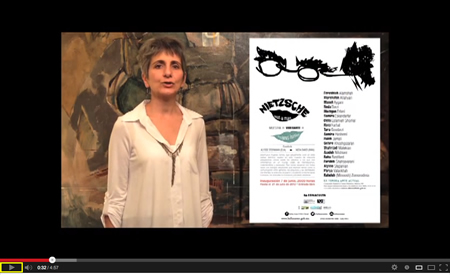
Watch video in Farsi: Alysse Stepanian discusses the concepts behind the exhibition.
View the online exhibition catalogue published by Ex Teresa Arte Actual, Mexico City.
For more information or to host this traveling exhibition, please contact Alysse Stepanian: info[at]alyssestepanian.com (replace [at] with @)
Nietzsche Was A Man
Video art by 19 Iranian womenCurated by Alysse Stepanian and Neda Darzi
Exhibition Text and Organized by Alysse Stepanian
(2009 – 2013)
Project Summary:
This exhibition of contemporary video art presents work by three generations of Iranian women currently living in seven countries. Historically Iranian filmmakers have captured the attention of international audiences with their powerful work. With the increasing accessibility of video technology and the use of the internet, many artists have crossed disciplines, encouraged by the potential to disseminate their video art worldwide. In this curation nineteen artists reveal unique perspectives on the questions faced in a volatile world of interrelationships, misapprehensions and hierarchies. The voices of these women resonate around the globe with challenging works that examine universal issues such as gender communication, prejudice and shifting identities, violence and war, and the relationship between humans, non-human animals, nature, and the environment.
Much debate has been centered around the seemingly misogynistic views of 19th Century German philosopher, Friedrich Nietzsche. Frances Nesbitt Oppel’s rereading of his aphorisms suggests that his remarks were ironic strategies designed to expose the hierarchical dualisms of Western thought and language, and to “ask us to question the ways in which we think about gender conventions” (Oppel, p. ix). Vanessa Lemm writes, “He [Nietzsche] believes that human life is inseparable from the life of the animal and of the whole organic and inorganic world” (Lemm, p. 4). In the English language, the word ‘man’ or ’mankind’ is often used to refer to the ‘human’ species in general. The title of this show points to the prevalent dualistic patriarchal worldview that subordinates and exploits nature and the powerless, separates men from women, and humans from animals.
The videos in this exhibition are grouped under six thematic headings: “Nature”, “Self”, “Walls”, “Defiance”, “Violence”, and “Displacement”. Although these works could be interpreted in multiple ways and grouped differently, I have tried to identify commonalities while remaining true to the artists’ original intentions.
_____________________________
References:
- Lemm, Vanessa. The Animal in Nietzsche’s Philosophy: Culture, Politics and the Animality of the Human Being. New York: Fordham University Press, 2009.
- Oppel, Frances Nesbitt. Nietzsche on Gender: Beyond Man and Woman. Charlottesville: University of Virginia Press, 2005.

